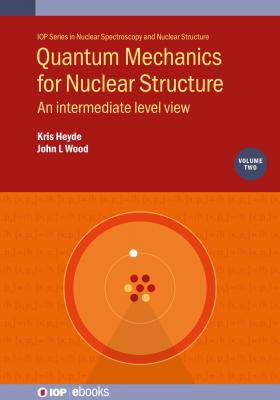Quantum Mechanics for Nuclear Structure, Volume 2. Professor Kris Heyde
Чтение книги онлайн.
Читать онлайн книгу Quantum Mechanics for Nuclear Structure, Volume 2 - Professor Kris Heyde страница 14

From the orthonormality of the D functions, sections 1.11 and 1.12,
I=(2j+1)4π∫dΩ∣θ,ϕ〉II〈θ,ϕ∣,dΩ=sinθdθdϕ.(1.292)
The states exp{ζ*J+−ζJ−}∣j,−j〉 are sometimes called ‘atomic coherent’ or ‘Bloch’ states (see, e.g. [4]).
The type-II coherent states of HW(1) can be generalised to SU(2):
∣z〉II≔exp(z*J+)∣j,−j〉.(1.293)
(∣ζ〉I and ∣z〉II are no longer trivially related, hence the use of z and ζ.)
The SU(2) states can be expressed in terms of the ∣z〉II:
∣Ψ〉→Ψ(z)=II〈z∣Ψ〉=〈−j∣ezJ−∣Ψ〉≔Ψj(z).(1.294)
Operators are mapped into z-space realisations, Γ(O) by
O∣Ψ〉→Γ(O)ΨJ(z)=〈z∣O∣Ψ〉=〈−j∣ezJ−O∣Ψ〉=〈−j∣(ezJ−Oe−zJ−)ezJ−∣Ψ〉=〈−j∣(O+[zJ−,O]+12[zJ−,[zJ−,O]]+⋯)ezJ−∣Ψ〉.(1.295)
Essentially all operators of relevance can be expressed in terms of J−, J0, and J+, whence: for O=J−
and from ∂∂z(ezJ−)=J−ezJ−
⇒Γ(J−)=∂∂z.(1.297)
For O=J0
and from z∂∂z(ezJ−)=zJ−ezJ−
⇒Γ(J0)=−j+z∂∂z.(1.299)
For O=J+
⇒Γ(J+)=2jz−z2∂∂z.(1.301)
Then
Γ(J0)znn!=(−j+n)znn!,n=0,1,2,…,(1.302)
Γ(J+)znn!=(2j−n)zn+1n!=(2j−n)n+1zn+1(n+1)!,(1.303)
Γ(J−)znn!=nzn−1n!=nzn−1(n−1)!.(1.304)
Comments
1 Starting from the state ∣j,−j〉, the raising action of Γ(J+) terminates at n=2j (as it should for SU(2)).
2 The representation is non-unitary, i.e. Γ(J+)†≠Γ(J−) for scalar products defined on Bargmann measure (for which (∂∂z)†=z).
3 This type of non-unitary representation is an example of a Dyson representation [5].
4 The ∣z〉II basis is defined on an SU(2) irrep labelled by j, i.e. it is a linear combination of the states ∣jm〉, m=j,j−1,…,−j.
1.19 Properties of SU(2) from coherent states
To obtain the properties of a quantum system which possesses an algebraic structure requires that unitary representations of the operators be found. This can be done in different ways. One way (which will not be developed here) is to change the measure of the z-space to enforce orthonormality. Thus, for the atomic coherent states:
I=∫∫dz(2j+1)π(1+∣z∣2)2j+2∣z〉II〈z∣(1.305)
provides resolution into orthonormal (unitary) representations in z-space. A second way (which is developed here) uses a similarity transformation. This choice is made because for higher symmetry algebras changing the measure of the z-space (even if it can be found!) involves very complicated integrals.
The non-unitarity of the z-space realisation of J−, J0, J+ —Γ(J−), Γ(J0), Γ(J+); (Γ(J+)†≠Γ(J−))—can be converted to a unitary realisation by a similarity transformation with an operator K:
γ(J−)=K−1Γ(J−)K,(1.306)
γ(J+)=K−1Γ(J+)K,(1.307)
γ(J0)=K−1Γ(J0)K,(1.308)
where it is required that
γ(J+)=(γ(J−))†.(1.309)
Now, from the form of Γ(J0)(=−j+z∂∂z), it is already Hermitian (z†=∂∂z). Thus, we have the condition that K commutes with Γ(J0) and so K is diagonal in m. Therefore, it is sufficient for K to simply normalize each ladder step in m, m=−j,−j+1,…,+j. Hence, for SU(2) it is sufficient for K to be a diagonal matrix. (For higher symmetry groups K will be more complicated.) The ‘K-matrix method’ is being introduced in the context of SU(2), where standard methods are simpler, to ‘see how it works’.
Then, from γ(J+)=K−1Γ(J+)K, multiplying from the left with K and from the right with K†
Kγ(J+)K†=KK−1Γ(J+)KK†.(1.310)
But
γ(J+)=(γ(J−))†=(K−1Γ(J−)K)†=K−1∂∂zK†=K†z(K−1)†,(1.311)
∴Kγ(J+)K†=KK†z(K−1)†K†=KK†z(KK−1)†,(1.312)
∴Γ(J+)KK†=KK†z.(1.313)
Thus, from the above condition that for SU(2), K is diagonal with real matrix elements,
∴Γ(J+)K2=K2z.(1.314)
The matrix elements of KK† (a real diagonal matrix for SU(2), KK†=K2) can be obtained by proceeding in either of two ways:
1 Take matrix elements, with Bargmann measure, between the states n,n+1, viz.〈χn+1∣Γ(J+)Kn2∣χn〉=〈χn+1∣Kn+12z∣χn〉.(1.315)
2 Introduce the auxiliary operator, Λop with the property[Λop,z]=Γ(J+),(1.316)whence(Λopz−zΛop)K2=K2z,(1.317)and then take matrix elements, with Bargmann measure, between states n,n+1, see the following.
The second way is easier to use for higher symmetry algebras and is the one developed here. (In particular, the second way solves for the representation of an algebra by obtaining the ratios of matrix elements of K, which are all that is ever needed.)
The motivation for defining Λop can be seen from the analogy between [Λop,z]=Γ(J+) and [J0,J+]=J+, recalling that for the hw(1) algebra, z=Γ(a†).
From